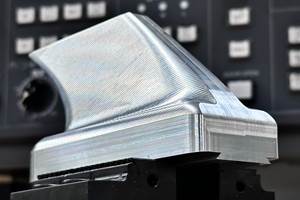Why Forming a Machine-Tool Buying Committee Is a Good Idea
With a decision as heavy as buying a new machine tool, it’s important to consider how such a purchase will touch all the relevant departments of the shop.
Share







There are many factors to be considered before acquiring a new machine tool, and a lot of questions have to be asked and answered prior to selecting the right CNC machine. This process includes asking questions about why the shop is buying in the first place and considering what size and sort of workpieces will be machined. It’s also useful to recall all the different people and departments the new machine will affect before moving to purchase.
Need a Meeting of the Minds? Form a Committee
During the machine-buying process, some companies will form committees, especially when numerous departments will be involved in and responsible for the daily operation of the machine. Buying committees allow each department to have input, conveying their requirements and concerns prior to machine selection.
Engineering: The engineering department may have concerns about the machine’s ability to achieve and maintain the required part specifications and accuracies.
Production: The production department will want to ensure that it will be able to meet agreed-upon production requirements and schedules.
Maintenance: The maintenance department will undoubtedly have concerns because its members will be forced to live with a poor machine selection. This department may be most interested in the machine’s spare parts; electrical components; electrical and air requirements; grease, air and oil filters; type of machine controller; recommended preventive maintenance procedures and their frequency; and general upkeep once installed.
Facility: Facility representatives might bring up concerns about factory space, machine footprint and layout, electrical and air drops, and fork truck access.
Purchasing: The purchasing department will want to make sure it understands the machine specifications and requirements in order to apply due pressure on the vendors to achieve the best financial deal and follow-up support for the company.
Machine selection by committee is usually done only in larger companies. Even then, if the machine is being purchased to replace an existing machine, and the required machine type and model are already known, a committee may not be necessary. In a job shop environment, the owner of the company may be the one purchasing the machine and may find the committee method unnecessary and far too time-consuming. Also, in smaller shops, the owner may be the person operating the machine and knows exactly what he or she wants without needing anyone else’s input.
Do Your Research
Inevitably, all machine buyers get to the point in the process of comparing machine types and machine models. , a free research center and analysis tool, can help anyone find the right machine for the job. This handy website database contains more than 500 machine tool brands with more than 8,600 models of every machine type imaginable—all in one place. Techspex maintains the deepest, most up-to-date machine tool information, whether the equipment is a milling, turning, grinding, EDM or coordinate measuring machine (CMM)—it’s all there. Simply enter the basic attributes and specifications that are required, and the system will provide a side-by-side comparison by machine type, model and builder.
This is part three of a three-part series about buying machine tools.
- Part one: So You’re in the Market for a Machine Tool—Start Your Search by Asking “Why”
- Part two: Before You Buy That New Machine Tool, Consider the Workpiece
Find more insights about acquiring a new machining center by visiting the Techspex Knowledge Center, “.”
This blog post was adapted from an article by Barry Rogers published in the Machine/Shop supplement to Modern Machine Shop magazine.
Related Content
2 Secondary Coordinate Systems You Should Know
Coordinate systems tell a CNC machine where to position the cutting tool during the program’s execution for any purpose that requires the cutting tool to move.
Read MoreObscure CNC Features That Can Help (or Hurt) You
You cannot begin to take advantage of an available feature if you do not know it exists. Conversely, you will not know how to avoid CNC features that may be detrimental to your process.
Read More4 Manufacturing Trends That Cannot Be Ignored
The next five years will present their own unique set of challenges, and shops can alleviate them by embracing these technologies and trends.
Read MoreCustom Workholding Principles to Live By
Workholding solutions can take on infinite forms and all would be correct to some degree. Follow these tips to help optimize custom workholding solutions.
Read MoreRead Next
AMRs Are Moving Into Manufacturing: 4 Considerations for Implementation
AMRs can provide a flexible, easy-to-use automation platform so long as manufacturers choose a suitable task and prepare their facilities.
Read MoreMachine Shop MBA
Making Chips and Modern Machine Shop are teaming up for a new podcast series called Machine Shop MBA—designed to help manufacturers measure their success against the industry’s best. Through the lens of the Top Shops benchmarking program, the series explores the KPIs that set high-performing shops apart, from machine utilization and first-pass yield to employee engagement and revenue per employee.
Read More



















